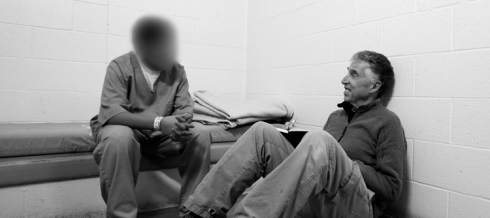 The statistic presented poster-style on photographer Richard Ross’s website (www.juvenile-in-justice.com) is gripping. California spends nearly $225,000 annually to house a young person in Alameda County’s new, green, LEED certified Juvenile Justice Center. At the same time, Alameda county is spending just $4945 annually per child in its Oakland public schools. The numbers grab us. Crime clearly pays someone. Ross’s beautiful color photographs of imprisoned youth grab us, too. A row of half grown boys lined up, backs turned, before a gigantic guard; a fifteen year old in bright orange Crocs sits in a bare concrete-block cell.
The statistic presented poster-style on photographer Richard Ross’s website (www.juvenile-in-justice.com) is gripping. California spends nearly $225,000 annually to house a young person in Alameda County’s new, green, LEED certified Juvenile Justice Center. At the same time, Alameda county is spending just $4945 annually per child in its Oakland public schools. The numbers grab us. Crime clearly pays someone. Ross’s beautiful color photographs of imprisoned youth grab us, too. A row of half grown boys lined up, backs turned, before a gigantic guard; a fifteen year old in bright orange Crocs sits in a bare concrete-block cell.
How to create that grab and channel it toward meaningful change is the focus of Project Pulse, a collaborative course and lecture series offered this winter at UCSB. Three professors, Ross in the art department, Victor Rios in sociology and Cissy Ross in the writing department, invite students in four courses—Studying People, Writing for the Social Sciences, Journalism and News Writing, and Photojournalism—to explore multiple strategies for creating effective advocacy. The course is called Justice.
Between them, the Rosses and Rios have an array of investigative tools. Cissy Ross spent 25 years as an award-winning journalist and editor in New York and California. Rios’s recent book Punished: Policing the Lives of Black and Latino Boys is not only the result of his academic research and youth mentoring in San Francisco and Santa Barbara, but also of his own gang experience as a young teenager. Richard Ross, trained as a fine art photographer, has for the past five years interviewed and photographed and more than 1000 youths in detention facilities in 30 states. ( A show of the work, Juvenile-in-Justice opens in the Nevada Museum of Art later this year.) Justice, the course, is a hands-on practicum in the art of integrating observation and action. It’s organized around individual research projects, which will be published on paper and on the web.
A series of guest speakers will also address the joint classes, beginning January 25th with David Inocencio, founder of The Beat Within, whose writing workshops for juvenile offenders in 13 CA counties have resulted an 80 page biweekly magazine, published by Pacific New Service. Other speakers range from the glamorous to the provocative: Mauro Bedoni, photo journalist and picture editor of Colors, the international youth-oriented issue and design magazine, Karen Grau, head of Calamari Productions, whose child welfare documentaries include the MTV series Juvies, and letterpress printmaker, teacher, and activist, Amos Kennedy. Based in Alabama, Kennedy gave up a career as a computer programmer to master pre-digital crafts including paper-making. His hand-printed posters re-imagine the sound byte as a meaningful statement, artistically presented and sold at near cost.
Discussing his prison photography Ross told an interviewer, “Nobody says, oh sure, come in.” Access is in large part a function of being sensitive to how institutions work—and what it’s like to work within them. To that end, the speaker series will also include the chief strategist for juvenile justice reform at the Annie E Casey Foundation, a private charitable organization dedicated to children and families, and two members of local law enforcement: Dustin Olsen, Chief of the UC Santa Barbara Police Department & Lieutenant Ray Vuillemainroy, Isla Vista Foot Patrol, Santa Barbara Sheriff’s Office.
The course’s collaborative structure extends to students as well. As they identify the area they will research they are urged to contact one another on the class website. Posts may begin with a proposal to share transportation but easily expand to a discussion of approaches and methods. Researchers need photographers and vice versa Professors weigh in, too,: a terrific idea still needs to take a tangible shape. an approach has to go beyond the image everyone knows. Great reporting demands more of everything: legwork, questions, thought, art.
###
Ariel Swartley
San Pedro, CA
aswartley@att.net


